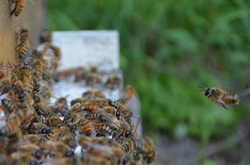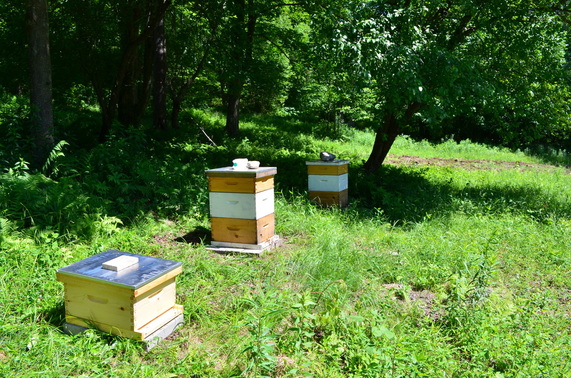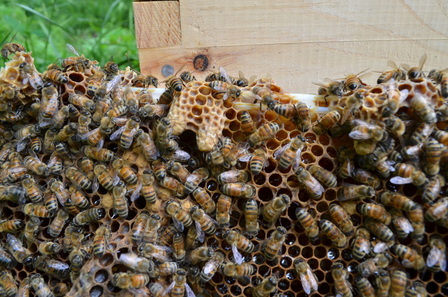|
My bees survived the winter, luckily! I had wrapped them in sheets of thick styrofoam and geotextile and made sure they were full of honey and pollen so they had enough food for the winter. I guess it paid off, since both hives were fairly strong as spring emerged. I started with two hives, and I had named them based on their collective temperament - Rose is the one on the left since it's a stronger colony and also a bit more aggressive. Daphne is on the right since the queen is less productive, so there are less bees, and they're more docile. Rose was the only one that produced enough honey last year for me to harvest (Daphne was a little slow getting off the ground), so I was expecting that it would continue to be pretty productive this year. When I say "productive", I mean that the queen lays a lot of eggs, so there are more worker bees, which means more worker bees make more honey. If I was keeping hives to make money or to have all of the honey I could possibly use, I would replace my less productive hive with a new queen so that I could harvest honey from both hives. But my nerdy biology goal is to raise bees that are adapted to my area, by splitting the strong hives as they grow and letting them make their own queen instead of continuously buying queens from a breeder, as most people do. It's a bit more risky to let the bees make their own queen, since then it needs to mate with males in the area (instead of coming inseminated already, as is when you buy them from a breeder), and it can get killed when it leaves the hive for this mating mission.  So over the weekend, I built a third hive. I'm not very mechanically minded so this actually took me a few hours to hammer all of the pieces together and paint them. Once it was all set up and the linseed oil I used was dry (I use linseed oil because it's less toxic than paint), I transferred a few frames from the strong hive into the new hive. Usually people put four or five frames from the old hive into the new hive, and those frames need to include honey (to give the new colony extra food if they need it), capped brood and eggs (developing worker bees so the population is continually replenished), adult worker bees, and a new queen cell. By chance, I found that the bees had been growing a new queen in a queen cell for their strong hive, which is a sign that they would have swarmed. Swarming is when the hive is too full or small for everyone, so the queen and a cluster of worker bees take off to start a new home, leaving more room for the new queen and rest of the workers. Once I put five frames from the Rose hive into the new hive (still trying to figure out a name for the new one), I added empty frames to make sure the hive was full, then I closed the lid. This is my first time splitting a colony, so I kind of saw it as an experiment - we'll see if it works!
0 Comments
|
About ShonaI'm an eco-conscious girl from Montreal, Quebec. I'm currently an adjunct science professor at Champlain College of Vermont (Montreal Campus). I'm interested in any opportunities to expand my experience with grassroots activism, climate change legislation, or environmental education. Archives
March 2016
Categories
All
|



 RSS Feed
RSS Feed
